Exploring the Spider-Man Tower: A Marvel Icon
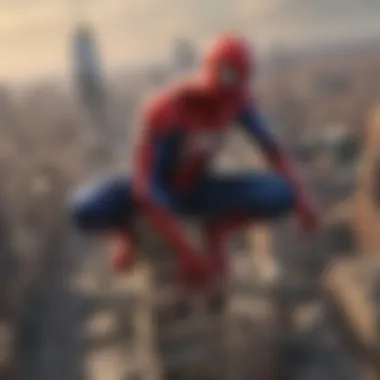
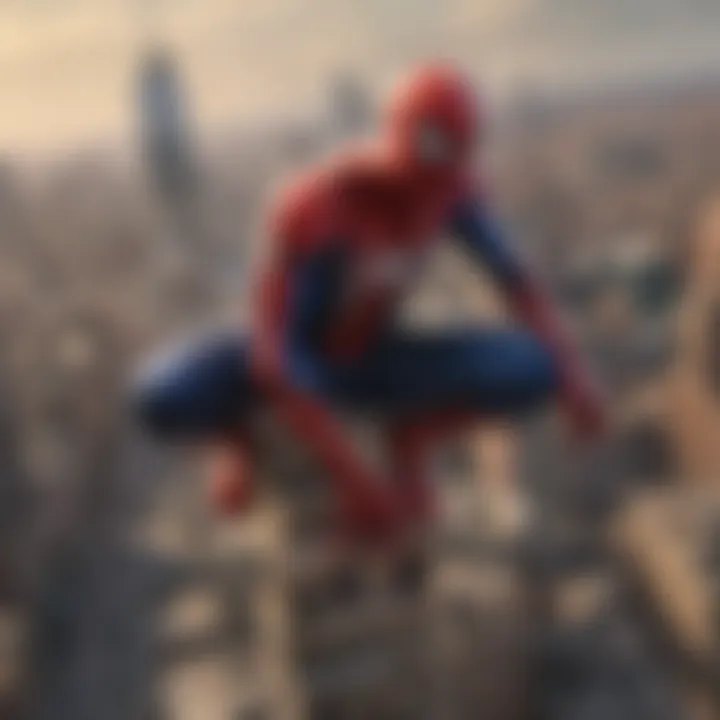
Intro
The Spider-Man Tower stands not only as an architectural landmark within the Marvel Universe but as a vital symbol of the superhero's journey and cultural relevance. This article investigates the representation of the tower across various media, encompassing comic books, films, and video games. By examining the unique attributes of the tower, we will uncover its role within superhero narratives and urban environments. Additionally, we will assess how this iconic structure resonates with Spider-Man's rich mythology and its impact on the fandom worldwide.
Spider-Man Character Analysis
Background
Spider-Man, created by writer Stan Lee and artist Steve Ditko, first appeared in "Amazing Fantasy" #15 in 1962. The character, Peter Parker, is a high school student who gains superpowers after being bitten by a radioactive spider. The origins of Spider-Man are crucial as they establish the duality of Peter Parker's life — balancing the everyday struggles of a teenager with the responsibilities of a superhero. His evolution over the decades reflects societal changes and personal growth, making him relatable to readers of all ages.
Powers and Abilities
Spider-Man is known for his extraordinary powers, which include superhuman strength, agility, and the ability to cling to walls. His spider-sense grants him a sixth sense of danger, allowing him to react swiftly. Additionally, the character's intelligence is significant; Peter Parker is a gifted scientist and inventor. This combination of physical and mental abilities sets him apart from many other superheroes, as he often relies on his wit and intellect to overcome challenges.
Character Development
Throughout his journey, Spider-Man faces numerous challenges that contribute to his character development. Key moments include his battles with iconic villains, the loss of loved ones, and the moral dilemmas he encounters as a hero. Each experience shapes him, reinforcing the core values of responsibility and sacrifice. Peter's mantra, "With great power comes great responsibility," resonates deeply, reminding readers of the weight of one's choices.
Latest Spider-Man News Update
Comic Books
Recent comic book releases featuring Spider-Man have explored new story arcs and introduced fresh characters. The ongoing series, "The Amazing Spider-Man," continues to captivate fans with its dynamic plots and engaging artwork. Updates from industry insiders indicate exciting developments on the horizon, suggesting a further expansion of Spider-Man's universe.
Movies
The Spider-Man film franchise remains a point of interest, with upcoming releases expected to make waves. Recent announcements regarding casting and trailers have generated considerable excitement among fans. These films not only bring Spider-Man to life but also serve as a platform to explore deeper themes within the superhero genre.
Video Games
Spider-Man video games have seen substantial growth in recent years, with engaging titles such as "Marvel's Spider-Man" and its DLCs received warmly by the gaming community. New gameplay enhancements aim to refine the gaming experience, offering players the chance to embody the character fully.
Top Villains in Spider-Man Universe
Main Antagonists
Spider-Man's journey is defined by his adversaries. Notable villains include the Green Goblin, Doctor Octopus, and Venom. Each antagonist presents unique challenges, testing Spider-Man both physically and emotionally. Their motivations often intersect with Peter Parker's personal life, adding layers to their conflicts.
Origins and Motivations
Understanding the origins of these villains provides insight into their motivations. The Green Goblin, driven by madness and envy, serves as a dark reflection of what Peter could become if he allowed his anger to consume him. Similarly, Doctor Octopus's obsession with scientific superiority contrasts with Peter's values, making their confrontations all the more impactful.
Memorable Battles
Iconic battles between Spider-Man and these villains have left an indelible mark on comic book history. The clashes are not only physical contests but also profound struggles that reflect the characters' inner conflicts. These moments showcase the complexities of heroism and villainy, providing readers with lessons about good and evil.
Spider-Man Movie Reviews
Plot Summary
The latest Spider-Man movies have revisited familiar stories while introducing new elements. These films often balance action with emotional depth, expanding the narrative universe of the character.
Character Portrayals
Character portrayals play a crucial role in the film's reception. Actors bring their interpretations to Spider-Man and supporting roles, creating memorable performances that resonate with audiences. The authenticity of their portrayals enriches the viewing experience.
Visual Effects
Visual effects in recent Spider-Man movies have elevated the action sequences to new heights. The use of CGI has facilitated breathtaking web-slinging scenes that capture the essence of Spider-Man's abilities, making them visually stunning and engaging.
The Spider-Man Tower stands as a testament to the enduring legacy of this beloved superhero, bridging comic book lore with the real urban landscape we inhabit.
Preamble to the Spider-Man Tower
The Spider-Man Tower stands as a testament to the web-slinger’s enduring legacy within Marvel's vast universe. Within this article, we will explore the multifaceted significance of this iconic structure, aiming to convey why its representation extends far beyond mere architecture. The Spider-Man Tower is intertwined with the character's narrative, providing not only a backdrop for thrilling adventures but also enriching the lore that surrounds Spider-Man.
Historical Context
In the realm of comic books, the Spider-Man Tower has evolved over the years. Initially, its presence symbolized Spider-Man's early days as a superhero. It showcased the character’s connection to New York City, reflecting the urban landscape that serves as much a character in the narrative as Spider-Man himself. As Marvel has changed its storytelling approach, this tower has been subject to numerous reinterpretations, each providing a unique reflection of the times.
The early comics introduced Spider-Man as a relatable figure struggling with everyday challenges, and the tower represented a safe haven as well as a site of conflict. Over time, it has also connected to larger story arcs where societal issues were addressed. The tower has become a symbol of resilience amidst change, mirroring Spider-Man’s own growth as a character.
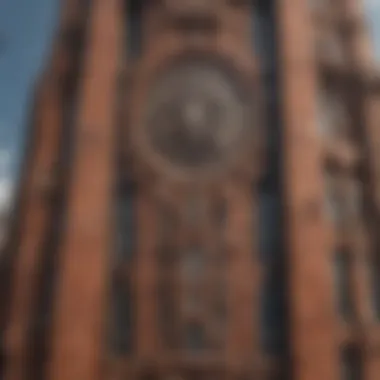
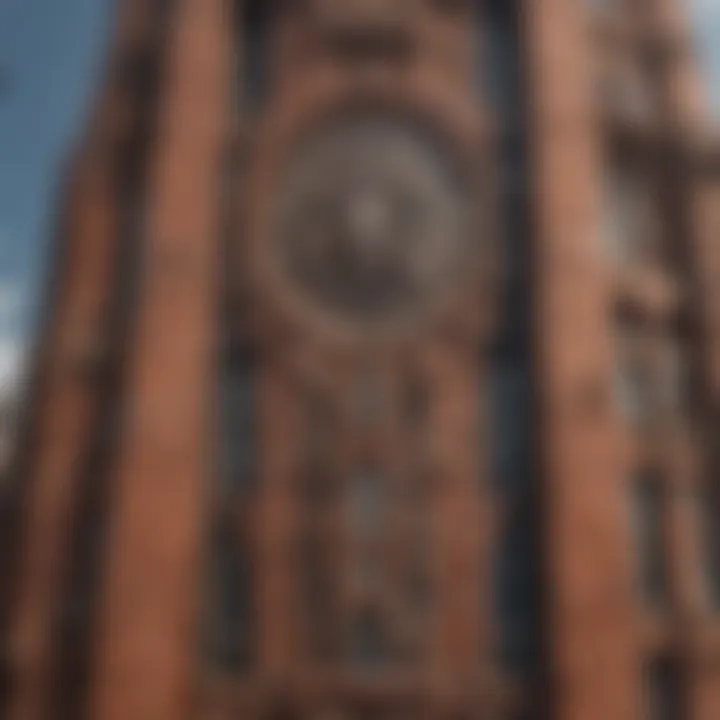
Location and Design
The Spider-Man Tower is usually depicted as located in a central position in Manhattan. This strategic location amplifies its significance in the comic book universe, making it a focal point for both the hero and his foes. The design often resembles real skyscrapers in New York but infused with comic book flair. It serves as a blend of imaginative architecture and the familiarity of actual city life.
Distinct features often include a sleek facade, vibrant colors, and sometimes even playful elements reflecting the lighthearted nature of the superhero. In various adaptations, the tower has been fitted with state-of-the-art technology to assist Spider-Man in his quests.
"The tower not only houses Spider-Man but also embodies his struggles and triumphs in a sprawling urban landscape."
Through these elements, the Spider-Man Tower remains a crucial aspect of the superhero's identity. As we progress in this article, we will further examine the tower's numerous layers of meaning within the Spider-Man mythos.
Significance in the Spider-Man Mythos
The Spider-Man Tower serves as a critical component of the wider Spider-Man narrative, providing depth to the character and stories that revolve around him. This structure is not just a fictional building; it embodies themes that resonate deeply with fans and contributes to the overall fabric of the Marvel Universe. Understanding the significance of the tower enhances comprehension of Spider-Man's journey and his place in a world filled with both heroism and vulnerability.
Symbol of Hope and Resilience
The nature of the Spider-Man Tower captures the essence of hope and resilience. Situated in the heart of New York City, a place often depicted with layers of struggle, the tower stands tall against adversity. This mirrors Peter Parker's own challenges as he balances his life as a student and a superhero. The tower often symbolizes the idea that one can rise above trials.
The urban landscape depicted in Spider-Man stories often entangles the hero with the everyday struggles of its inhabitants. In many instances, the tower is the beacon from which Spider-Man operates, signifying that hope is accessible, even amid chaos.
Fans appreciate this imagery, as it not only embodies Spider-Man's grit but also reflects the audience's own experiences in overcoming life's difficulties. When they see the Spider-Man Tower, they see a part of themselves in the hero's narrative.
Connection to Spider-Man's Identity
The tower is intrinsically linked to Spider-Man's identity. It serves as a physical representation of his duality. Peter Parker, the young man constantly burdened by responsibilities, contrasts with Spider-Man, the hero who swings through the skies, embodying freedom and courage.
This architectural element is often where significant moments unfold in both comics and films. For instance, it can be the setting for heartfelt realizations or intense battles, reinforcing its role in his identity. The tower becomes a backdrop for key character development, showing how intertwined his emotions and decisions are with this structure.
"The Spider-Man Tower is more than just a location; it is a crucible for defining moments in Spider-Man's journey."
In summary, the tower emphasizes key traits of Spider-Man: his resilience and the complexity of his character. It reminds both fans and casual observers alike that being a hero involves personal sacrifice and a commitment to the greater good. This structure is not merely an urban landmark; it is a critical element that enriches Spider-Man's overarching story.
Architectural Elements of the Tower
The architectural elements of the Spider-Man Tower serve as a critical foundation to understanding its role within the Marvel Universe. These elements reflect the blend of aesthetic appeal and functional design that resonates deeply with Spider-Man's narrative. The tower symbolizes not only a physical structure but also a realm of possibilities tied to urban dynamics in superhero tales.
Structural Design
The structural design is paramount to the tower's identity. It is often depicted as a towering, sleek skyscraper that stands tall against the New York City skyline. The use of modern materials, like glass and steel, aids in creating an image of strength and agility, mirroring Spider-Man's own capabilities. The dimensions are usually exaggerated in comics and films, showcasing a majestic height that symbolizes excellence and aspiration.
This design also allows for significant use of open spaces, which emphasizes the connection between the tower and the city. Windows often adorn the facade, giving potential onlookers a glimpse into the bustling life within — a life that embodies the challenges and triumphs faced by both Peter Parker and his heroic alter ego. Through this lens, the structure becomes a character in its own right, inhabiting the same urban landscape that Spider-Man navigates.
Key Features of the Structural Design:
- Height: A towering presence in the skyline, representing aspiration and ambition.
- Materials: Glass and steel, symbolizing resilience and modernity.
- Open Spaces: Provides a glimpse into the life within and emphasizes connection to the city.
Symbolic Features
Beyond its physical attributes, the tower is imbued with symbolic significance. The architectural features often reflect themes of resilience and hope, consistent with Spider-Man’s journey. For instance, when depicted during crises or battles, the tower usually remains standing tall, representing the indomitable spirit of those who defend their city.
Many illustrations involve the tower during moments of triumph, such as when Spider-Man saves citizens or foils villainous plots. These key moments use the structure as a background to highlight themes of heroism, echoing the fight against adversity.
Additionally, the design sometimes incorporates elements reminiscent of spider webs, subtly hinting at the central theme of the Spider-Man narrative. The intentional use of geometry not only serves an aesthetic purpose but also reinforces the narrative connections to the spider motif.
"The architectural mix of functionality and symbolism makes the Spider-Man Tower a staple in storytelling, enhancing both character and narrative depth."
In summary, the architectural elements of the Spider-Man Tower are more than mere design choices; they embody the spirit of the stories surrounding Spider-Man. They reflect a harmony of structure and symbolism that resonates deeply with fans and enriches the overall Marvel narrative.
Portrayal in Comic Books
The portrayal of the Spider-Man Tower in comic books holds significant weight in understanding its role within the broader Spider-Man narrative. This iconic structure not only serves as a backdrop for critical events, but also enhances the storyline through its dynamic relationship with the characters associated with it. The visual representation of the tower often evokes a sense of setting that complements the emotional and thematic aspects of Spider-Man's adventures. Therefore, examining the key story arcs and different artistic interpretations becomes essential for a comprehensive view of its role in the Spider-Man universe.
Key Story Arcs Involving the Tower
Several pivotal story arcs showcase the Spider-Man Tower as a central element within the narrative. Notably, it often features prominently during battles with foes and in moments of personal reflection for Peter Parker. For example, in the storyline "The Night Gwen Stacy Died," the tower serves not just as a physical location but also as a symbol of Peter’s grappling with loss and responsibility. It is in this space that he faces not only external threats but also his internal struggles.
Additionally, arcs like "Spider-Verse" emphasize the connectivity of various Spider-beings, highlighting how the tower embodies a larger multiverse concept. The tower stands as a point of convergence, bridging realities and suggesting that each Spider-Man, regardless of the universe, shares a common heritage tied to this structure. This fosters a rich narrative environment where themes of legacy and unity among diverse characters thrive.
Moreover, events like the "Clone Saga" explore the tower’s role in the exploration of identity, as clones grapple with their existence against the backdrop of this significant locale. Each story arc not only utilizes the tower as a landmark but enhances its significance through character development and emotional stakes.
Artist Interpretations
Artist interpretations of the Spider-Man Tower vary widely, providing a unique lens through which fans perceive the environment of Spider-Man's world. In earlier comics, the tower is depicted in a relatively straightforward architectural style, emphasizing its functionality rather than aesthetic appeal. As time progressed, artists like John Romita Jr. introduced more stylized designs that accentuated the tower’s height and presence, contributing to a more dynamic visual narrative.


The contemporary portrayal of the tower often incorporates elements that reflect current architectural trends, symbolizing the evolution of urban landscapes within the Marvel Universe. Various artists use perspective and contrast to create immersive scenes where the tower looms over the characters, creating a dramatic effect that underscores the idea of Spider-Man as an urban hero.
These artistic choices also influence how readers perceive the tower's symbolic nature. From a representation of power and hope to an architectural metaphor for resolve in the face of adversity, each illustration contributes layers of meaning. The tower becomes not just a setting, but a character in its own right, pivotal to the stories in which it features.
In summary, the portrayal of the Spider-Man Tower in comic books is multifaceted. Through key story arcs, it ties deeply into Peter Parker's identity and struggles, while artist interpretations enrich its significance, offering fans a complex view of this emblematic structure.
Film Representation of the Tower
The inclusion of the Spider-Man Tower in films marks a critical juncture in the representation of Spider-Man's world. This visual element reinforces the character's relationship with New York City. Each appearance is not merely about showcasing a building; it provides context for Spider-Man's adventures and represents his struggle against urban challenges.
Appearance in Major Films
The Spider-Man Tower, often serving as a backdrop, appears prominently in several major films. In Spider-Man: Homecoming, the tower symbolizes Spider-Man's aspirations as he navigates the complexities of being a teenager and a hero. The visuals capture the urban landscape, mirroring the character's dichotomy of hope and burden. This framing device allows audiences to grasp the essence of the character's environment, enhancing narrative depth.
In contrast, The Amazing Spider-Man 2 integrates the tower with heightened emotional stakes. Here, it becomes a place of confrontation, escalating tension between Spider-Man and his adversaries. The tower's imposing presence accentuates the hero's physical abilities and emotional turmoil, creating a compelling viewing experience.
Fan Reactions and Critiques
Fans often engage in heated discussions when it comes to the representation of the Spider-Man Tower in films. Many appreciate the efforts to maintain authenticity. A strong reaction surfaces when discrepancies occur between comic portrayals and their cinematic counterparts.
"The Tower needs to feel alive, just like Spidey!" – a common sentiment expressed in online forums.
Critiques also focus on the visual representation. While some believe the tower should always evoke the sense of New York, others argue that films sometimes overlook its symbolic implications. This duality of perspectives showcases a deeper understanding of the building's role in Spider-Man's narrative.
Ultimately, the tower's portrayal in films significantly impacts how we perceive Spider-Man's identity. It connects visual storytelling to mythos, reaffirming its place as an essential landmark in both New York's skyline and the Spider-Man legacy.
The Tower in Video Games
The integration of the Spider-Man Tower in video games signifies a crucial element in developing narratives and gameplay that resonate with fans. The tower not only serves as a recognizable landmark but also embodies the essence of Spider-Man's universe. This section will expound on its in-game representation and the gameplay mechanics that leverage the tower's presence.
In-Game Representation
In various video games, the Spider-Man Tower is depicted with attention to detail, showcasing its significance in the urban landscape of New York City. Titles such as Spider-Man (2018) by Insomniac Games have brought the tower to life. Here, players can visit the tower, appreciating its architecture and centrality within the game's open world. The design captures the essence of the tower as a symbolic bastion of Spider-Man’s adventures.
Moreover, developers incorporate the tower into larger narratives, often positioning it as a hub of crucial events. In many narratives, it serves as a backdrop for climactic confrontations or emotional moments within the story. The tower acts as a grounding point for players, reminding them of Spider-Man's enduring legacy and responsibilities.
Gameplay Mechanics Involving the Tower
The gameplay mechanics associated with the Spider-Man Tower enhance the overall experience for players. One notable aspect is the tower's role in serving as a fast travel point. This mechanic enables players to navigate the expansive city efficiently while maintaining immersion in the Spider-Man mythos. By allowing quick access to various locations, the tower promotes exploration and engagement with the game world.
In addition to fast travel, the tower is often tied to missions and objectives. Players might need to complete challenges or rescue civilians near the tower, reinforcing the connection between the hero and this iconic structure.
Furthermore, the tower can serve as an interactive environment during combat scenarios. Players may find themselves swinging around or scaling the tower while engaging in battles with villains. This dynamic use of the tower adds depth to the gameplay and allows players to utilize their skills effectively.
The tower's representation in video games is not merely aesthetic; it is integral to gameplay and narrative.
As seen in Marvel’s Spider-Man video game series, the tower is more than just a place; it embodies the spirit of heroism that Spider-Man stands for. Its presence across various platforms ensures its place in the hearts of fans and reinforces the broader Spider-Man narrative.
Cultural Impact of the Spider-Man Tower
The Spider-Man Tower plays a vital role in the cultural landscape surrounding the character of Spider-Man and the broader Marvel Universe. This structure embodies more than just a physical presence in the stories; it resonates with themes of heroism, community, and resilience. Through various media, the tower has evolved into a significant symbol that captures the imagination of fans and casual observers alike.
Influence on Urban Architecture
The architectural design of the Spider-Man Tower has left a mark on both fictional and real-world urban landscapes. The tower stands as an exemplar of modern skyscraper design, with its unique features reflecting a blend of practicality and artistic expression. The visual representation, often resembling New York City’s skyline, prompts a reflection on how urban environments shape narratives.
Urban architecture in reality can see shifts when influenced by media representations. Architects might draw inspiration from the dramatic elements of the Spider-Man Tower, driving innovations in how skyscrapers are conceptualized and realized. This influence is felt in discussions about sustainable design, where the tower could symbolize a future approach to integrating green spaces within urban settings.
Additionally, the idea of a skyscraper as a superhero's base challenges traditional notions of space in cities. Fans and architects alike consider how such structures can bridge functionality and fantasy, capturing elements that enhance public engagement with architecture. The reasoning behind this can be traced back to how symbolic buildings contribute to a city's identity, particularly one as densely populated as New York.
Representation in Popular Culture
The representation of the Spider-Man Tower extends beyond comics and films into various aspects of popular culture. It appears in merchandise, video games, and themed events, further engraining it into the collective psyche of fans. Icons like this tower offer a physical representation of themes central to Spider-Man’s story, such as the balance between personal struggle and public responsibility.
In video games, players often find themselves immersed in a digital version of the tower, enhancing their connection to the Spider-Man universe. This interaction serves to deepen their appreciation for the character’s narrative. Cultural events, such as conventions and public gatherings, frequently showcase the tower in decorations and cosplay, illustrating its widespread significance among fans.
The Spider-Man Tower remains a constant reminder of a superhero's impact on the urban landscape, embodying ideals that resonate across generations.
Merchandising also highlights this cultural importance. From action figures to art prints, the tower is depicted in diverse formats, reaching various demographics. Documentaries and discussions in online communities amplify its relevance, showcasing enthusiasm and analysis that fuels further interest in its narrative implications.
Overall, the Spider-Man Tower's influence transcends comic books and films, solidifying its status in urban architecture and popular culture, making it a vital element in the examination of Spider-Man's legacy.
Fandom and Community Engagement

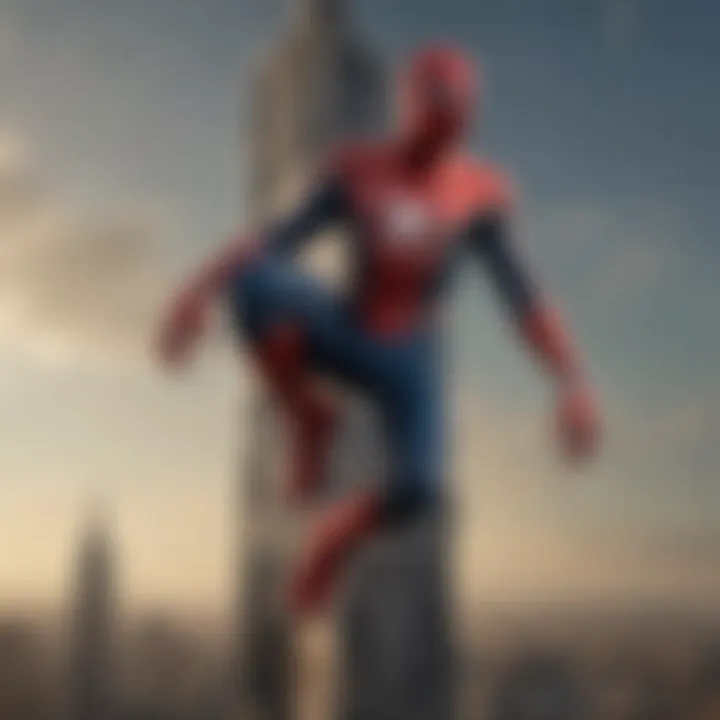
Fandom and community engagement surrounding the Spider-Man Tower plays a critical role in fostering a vibrant culture among enthusiasts. Fans do not just consume content; they actively participate in discussions, express their creativity, and share their interpretations of the tower's significance. This interaction strengthens the bond between the fans and the Spider-Man narrative, highlighting how a fictional structure can resonate deeply with its audience.
Community engagement also offers various benefits. It allows fans to form connections with others who share similar interests. In online forums or social media groups, users dissect story arcs, share personal experiences, and even speculate on future developments. The Tower serves as a focal point for these conversations, embodying complex themes within the Spider-Man mythos. The active involvement of the community helps keep the narrative alive, enabling fans to feel a sense of ownership over the stories told.
Moreover, the inclusion of diverse voices enhances the richness of discussions. Conversations often explore new perspectives and theories about the Tower's role in the superhero genre, allowing for a fuller understanding of its impact on the overall Marvel Universe.
"The Spider-Man Tower is not just a location; it symbolizes the collective creativity and passion of its fans."
This shared enthusiasm fosters a sense of belonging, creating a space where fans can celebrate their love for Spider-Man without judgment.
Online Communities and Discussions
Online platforms serve as vital hubs for fandom engagement around the Spider-Man Tower. Websites like Reddit and Facebook host numerous groups and threads dedicated to discussing everything from comic book lore to fan theories. These platforms allow fans to share artwork, cosplay photos, and even personal stories related to their experiences with Spider-Man.
Participants build knowledge bases over time. Discussions evolve as fans reference specific comic issues, films, or video games that include the Tower, enriching the experience for newcomers who might be discovering the narrative for the first time. In this way, the Tower becomes an entry point for deeper conversations about Spider-Man himself.
Key aspects often highlighted in these discussions include:
- Various depictions in comic books and films
- The architectural significance of the Tower
- The Tower's connection to important plot points in Spider-Man's life
By centering conversations around the Tower, fans not only reinforce its importance within the narratives but also promote a broader appreciation for the artistic craftsmanship behind Spider-Man stories.
Cosplay and Fan Art Inspired by the Tower
Cosplay and fan art are two powerful forms of expression in the Spider-Man community, particularly in relation to the Tower. Fans often choose to create costumes inspired by Spider-Man's world, and the Tower serves as an iconic backdrop or theme for these costumes. Cosplayers depict not only Spider-Man but also other characters associated with the Tower in various narratives, showcasing their insights and interpretations.
Fan art, ranging from digital illustrations to traditional sketches, similarly draws influence from the Tower’s visual narrative. Artists often focus on:
- Capturing the architectural features of the Tower
- Creating scenes that involve iconic moments near or within the structure
- Imagining alternate realities where the Tower plays a different role in Spider-Man's story
Both cosplayers and artists contribute to the cultural impact of the Spider-Man Tower, elevating it from a mere structure to a symbol of creativity and community. Through their work, fans celebrate their shared love for the character while also inspiring new discussions about Spider-Man's myriad interpretations.
Engagement at this level strengthens the community, empowering fans to explore their passions creatively, thus ensuring the Spider-Man Tower remains an enduring icon.
The Future of the Tower in Spider-Man Narratives
The Spider-Man Tower stands not just as a fixture in the Marvel Universe but as a beacon for storytelling. Its future in comics and other media is critical for several reasons. It embodies the ongoing evolution of the Spider-Man character and the narratives intertwined with his life. The tower will likely retain its role as a central point in Spider-Man's adventures, continuing to reflect the themes of responsibility and heroism.
Potential Developments in Comics and Media
In the comic book world, the Spider-Man Tower may see various adaptations depending on the direction writers choose. Future story arcs might explore shifts in the tower's architectural design, reflecting changes in the character's life. For instance, after critical events like significant battles or personal losses, it is possible that the tower sustains damage and faces reconstruction. This represents Spider-Man's resilience and connection to New York City.
Moreover, collaborative projects within the Marvel Comics universe might lead to interesting crossovers involving the tower. The dynamic between Spider-Man and other heroes or even villains can enrich the narrative landscape. New stories can unfold as other characters navigate their relationships with the tower.
In non-comic media, such as films and animated series, we may also expect fresh representations. It could become a hub for advanced technology that serves the hero’s initiatives, integrating modern elements into its layout or purpose. New adaptations may also incorporate digital effects to enhance the tower's presence, showcasing its significance.
Impact of Digital Platforms on Representation
Digital platforms are reshaping how content is consumed and produced. This change directly impacts how the Spider-Man Tower is depicted in various narratives. With webtoons, apps, and streaming services engrossing audiences, the possibilities for storytelling have expanded dramatically.
The representation of the tower could take on more interactive elements. For instance, games or virtual experiences could allow fans to explore the tower in ways that traditional media cannot offer.
Fan contributions on platforms like Reddit or Facebook can inform new content, drawing on community interpretations and desires. This engagement gives a voice to the audience, which can shape future narratives involving the tower.
Ultimately, the future of the Spider-Man Tower in narratives appears promising. By embracing changes in storytelling mediums and exploring the character's depth, it ensures the tower continues to resonate with audiences for years to come.
End: The Legacy of the Spider-Man Tower
The Spider-Man Tower stands as a monument within the vast Marvel Universe. Its legacy is not solely defined by its architectural might, but by its influence on fans, media, and superhero culture. The tower reflects the enduring nature of Spider-Man’s character and the stories that encompass him. The significance of this structure is evident in how it encapsulates the complexities of urban life and heroism. This article explored the roles this iconic tower plays in various mediums and how it resonates with audiences.
Enduring Appeal for Fans
For many fans, the Spider-Man Tower is a catalyst for nostalgia and admiration. It represents a sense of belonging within the Spider-Man community. This community engages with the tower through different forms:
- Fan Art: Artists often depict the tower in various interpretations, showcasing its aesthetic and symbolic traits.
- Cosplay: Enthusiasts embody Spider-Man, using the tower as a backdrop for their expressions of fandom.
- Discussions on platforms: Reddit and Facebook groups frequently highlight this structure, allowing fans to share insights, theories, and memories.
Ultimately, the fans’ connection to the tower reveals its role as a bridge between the fictional universe and the real world.
Significance in the Marvel Universe
The Spider-Man Tower's significance in the broader Marvel Universe cannot be understated. It serves as a pivotal location in various story arcs. Characters often converge here for battles, alliances, and moments of reflection. The tower’s presence is felt in both the comic books and cinematic adaptations. It emphasizes themes of responsibility, sacrifice, and heroism—a core essence of Spider-Man's character.
The architectural elements of the tower also resonate with comic book lore. They suggest strength and resilience, mirroring Spider-Man's journey. Furthermore, as urban landscapes evolve, the tower remains a steadfast symbol. It endears itself to each new generation of readers and viewers, reinforcing its status in popular culture.
The legacy of the Spider-Man Tower is a tapestry woven with threads of hope, realization, and community. Its story continues to unfold, inviting all to be a part of Spider-Man's world, ensuring that its impact will not fade into obscurity.
"In the end, the tower is not just a building; it is a testament to what Spider-Man stands for."
Through continued exploration and engagement, the Spider-Man Tower sustains its place in the hearts of fans and within the Marvel Universe as a revered symbol of heroism.







